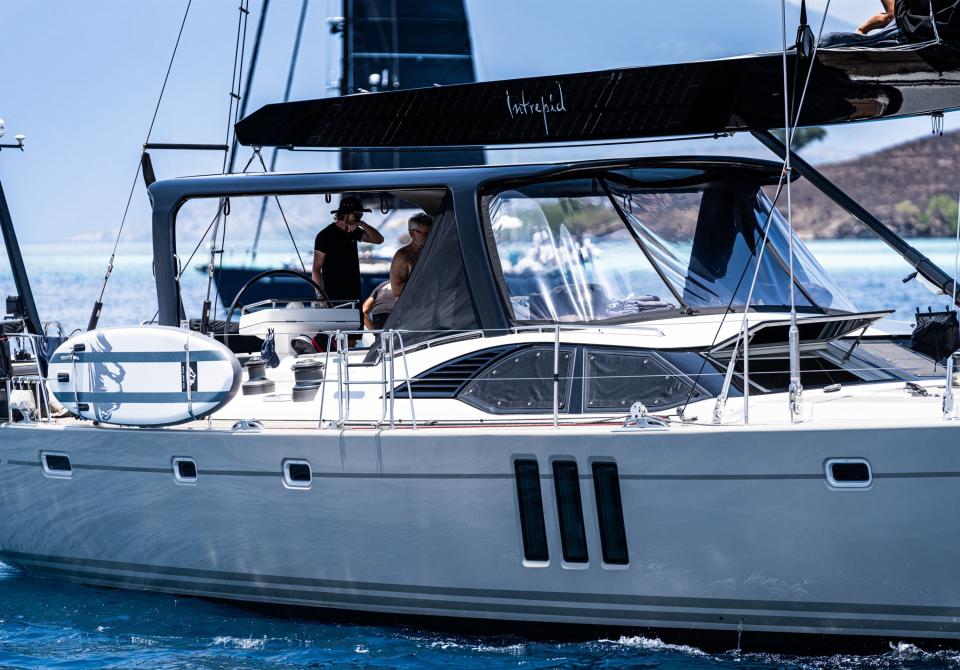A former marine systems engineer with the Royal Canadian Navy, later a serial entrepreneur, Hill knew the technology existed to sail silently across oceans, while still being able to enjoy every on board comfort, but it would take a new approach.
His answer was a system with high capacity, lithium-ion battery banks, generator and inverters, topped off with solar panels permanently installed on a lightweight hard top. The green energy derived from what he calls his ‘solar Bimini’ has been transformative, drastically reducing the runtime and servicing of all the mechanical systems and giving hour after hour of silent running. From both the environmental and practical standpoint, it is a winner. “We think we could sail across the whole of the Pacific and arrive with 80-90% of our fuel capacity left,” says Hill.
IS IT POSSIBLE TO SAIL ACROSS OCEANS WITHOUT THE BACKGROUND NOISE OF A GENERATOR WHILE STILL ENJOYING ALL THE ON BOARD COMFORTS OF HOME? TREVOR HILL DECIDED IT WAS – SEE HOW HE SUCCESSFULLY REBUILT HIS OYSTER 725’S POWER SYSTEMS IN PREPARATION FOR THE OYSTER WORLD RALLY.
His starting point was to replace the boat’s ageing gel batteries with 12 lithium-ion batteries of 200 a/h each. He calculated that while on passage, with an estimated steady state load of 40-50a, Intrepid would then be able to sail for 48 hours on battery power alone.
“Then,” he adds, “I started to think that I could augment that further with solar power and last even longer.”
He says he thought: “How can we improve a cockpit with average functionality, which has a dodger with a Bimini over it? Waves sometimes came through and we wanted to improve that. We had the idea of making a hard Bimini and thought it could be large enough for a significant number of solar panels yet also sexy enough to be a real contributor.”
Hill worked with Oyster Palma to commission a hard top design made of carbon. Between them, Oyster, BMComposites and Electromarine, they designed and created a fully integrated, permanent carbon Bimini large enough to carry 2,200w of solar panels.
As well as looking sleek and fitting with the lines of the yacht, the Bimini features a windscreen that increases shelter and warmth in the cockpit during inclement conditions. To top it all off, the interior was fitted out with speakers and mood lighting.
Although solar energy is the magic ingredient in Intrepid’s power system, Trevor also set out to increase or optimise every other element. He upgraded the engine alternator to a 320a unit and doubled the number of chargers on the Genset. The electrical configuration was changed so that the new batteries could power much more of the yacht’s systems through three new 4,000w inverters and an auxiliary inverter, giving a total of 17,000w of power.
The yacht’s air conditioning, watermaker and main systems were switched over to run on a primary bus. This means, says Hill, “that if I have guests on board, for example, we can run air con in the cabins without the engine or generator running and that doesn’t draw much power.”
In October 2021, Trevor and Judy Hill left Palma on the first leg of their circumnavigation, sailing out of the Mediterranean to Madeira and the Canary Islands before crossing the Atlantic in November and then joining the Oyster World Rally. By the end of 2022, they had reached South Africa and had been able to gauge how their power generation solutions work over the long haul.
Hill says that when they are passage making, they can go for 60 hours on battery power, topped up only with solar power, provided they don’t run the air con. “That’s all the ship’s load plus autopilot, winches, etc,” he says. “At peak sun, the solar panels are well capable of running these and adding modestly to the batteries. To charge the batteries from near empty to full, however, we need about four hours on the generator and closer to 8 or 10 on the engine alternator.
“But because we built in the capacity to put all the ship’s load on the new inverter bank, we can run everything, from air con, watermaker and appliances to ship’s load, from the batteries at all times. This has allowed us to use air con in the cabins during passages, which we started with gradually but has now become constant. In the heat of the tropics. This was a spectacular benefit to all and made for very comfortable cabins at 22-23°C.
“This is much more power-hungry, but still, we only need to run the generator for four hours in a 24-hour period.”
He adds: “The conversion has allowed us to make and store energy much more efficiently but also use it in ways that few yachts of our class can. All in all, the upgrades we made to the electrical system have been excellent and we have used them all, continuously.”
The conversion has allowed us to make and store energy much more efficiently but also use it in ways that few yachts of our class can. All in all, the upgrades we made to the electrical system have been excellent and we have used them all, continuously.
